We use cookies on this site to enhance your experience.
By selecting “Accept” and continuing to use this website, you consent to the use of cookies.
Search for academic programs, residence, tours and events and more.
NSSE annually collects information at hundreds of four-year colleges and universities about student participation in activities and programs that promote their learning and personal development. The results provide an estimate of how undergraduates spend their time and what they gain from attending their college or university. Institutions use their data to identify aspects of the undergraduate experience that can be improved through changes in policy and practice.
NSSE has been in operation since 2000 and has been used at more than 1,500 colleges and universities in the U.S. and Canada. More than 90% of participating institutions administer the survey on a periodic basis.
Visit our website: nsse.indiana.edu.
Student engagement represents two critical features of collegiate quality. The first is the amount of time and effort students put into their studies and other educationally purposeful activities. The second is how institutional resources, courses, and other learning opportunities facilitate student participation in activities that matter to student learning. NSSE surveys first-year and senior students to assess their levels of engagement and related information about their experience at your institution.
This snapshot is a concise collection of key findings from your institution’s NSSE 2014 administration. We hope this information stimulates discussions about the undergraduate experience. Additional details about these and other results appear in the reports referenced throughout.
Sets of items are grouped into 10 engagement indicators, organized under four broad themes. Below are summary results for your institution. For details, see your Engagement Indicators report.
| Engagement Indicator | First Year | Senior |
|---|---|---|
| Higher-Order Learning | No significant difference. | Your students’ average was significantly higher (p < .05) with an effect size less than .3 in magnitude. |
| Reflective and Integrative Learning | Your students’ average was significantly higher (p < .05) with an effect size less than .3 in magnitude. | Your students’ average was significantly higher (p < .05) with an effect size less than .3 in magnitude. |
| Learning Strategies | Your students’ average was significantly lower (p < .05) with an effect size less than .3 in magnitude. | No significant difference. |
| Quantitative Reasoning | Your students’ average was significantly higher (p < .05) with an effect size less than .3 in magnitude. | No significant difference. |
| Engagement Indicator | First Year | Senior Year |
|---|---|---|
| Collaborative Learning | Your students’ average was significantly higher (p < .05) with an effect size less than .3 in magnitude. | No significant difference. |
| Discussions with Diverse Others | No significant difference. | Your students’ average was significantly lower (p < .05) with an effect size less than .3 in magnitude. |
| Engagement Indicator | First Year | Senior Year |
|---|---|---|
| Student-Faculty Interaction | Your students’ average was significantly higher (p < .05) with an effect size less than .3 in magnitude. | Your students’ average was significantly higher (p < .05) with an effect size less than .3 in magnitude. |
| Effective Teaching Practices | Your students’ average was significantly higher (p < .05) with an effect size less than .3 in magnitude. | Your students’ average was significantly higher (p < .05) with an effect size less than .3 in magnitude. |
| Engagement Indicator | First Year | Senior Year |
|---|---|---|
| Quality of Interactions | Your students’ average was significantly higher (p < .05) with an effect size less than .3 in magnitude. | Your students’ average was significantly higher (p < .05) with an effect size less than .3 in magnitude. |
| Supportive Environment | Your students’ average was significantly higher (p < .05) with an effect size less than .3 in magnitude. | Your students’ average was significantly higher (p < .05) with an effect size less than .3 in magnitude. |
Due to their positive associations with student learning and retention, special undergraduate opportunities are designated "high-impact." For more details and statistical comparisons, see your High-Impact Practices report.
The opportunities include learning community, service-learning, and research with faculty.
The graph below shows that in first year:

The opportunities include learning community, service-learning, research with faculty, internship, study abroad and culminating senior experience.
The graph below shows that in senior year:
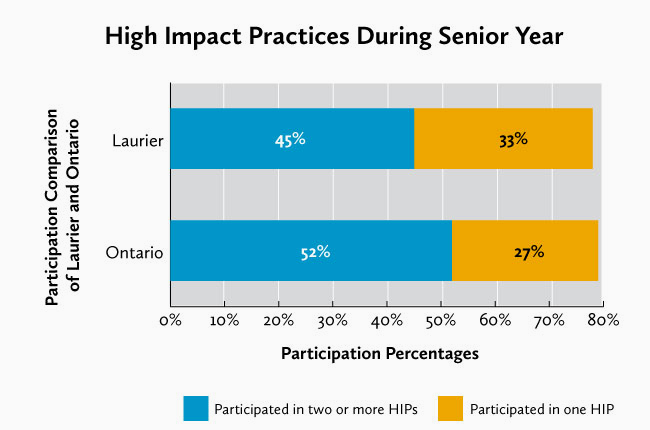
Comparison Group
The comparison group featured in this report is Ontario. See your Selected Comparison Groups report for details.
The academic challenge theme contains four engagement indicators as well as several important individual items. The results presented here provide an overview of these individual items. For more information about the academic challenge theme, see your Engagement Indicators report. To further explore individual item results, see your Frequencies and Statistical Comparisons, the Major Field Report, the Online Institutional Report, or the Report Builder – Institution Version.
The figure below reports the average weekly class preparation time for your first-year and senior students compared to students in your comparison group.
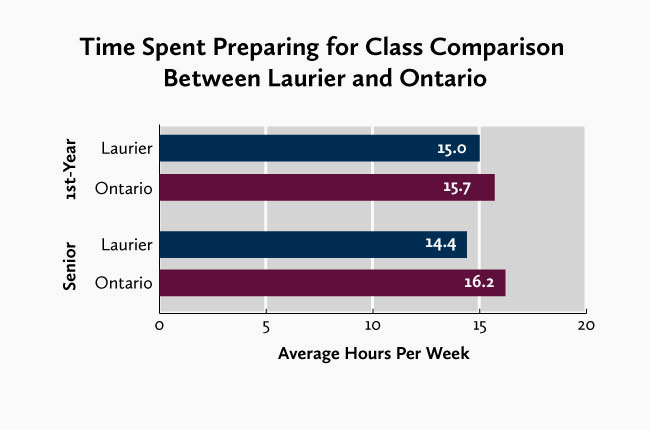
These figures summarize the number of hours your students spent reading for their courses and the average number of pages of assigned writing compared to students in your comparison group. Each is an estimate calculated from two or more separate survey questions.
The graph below reports that:
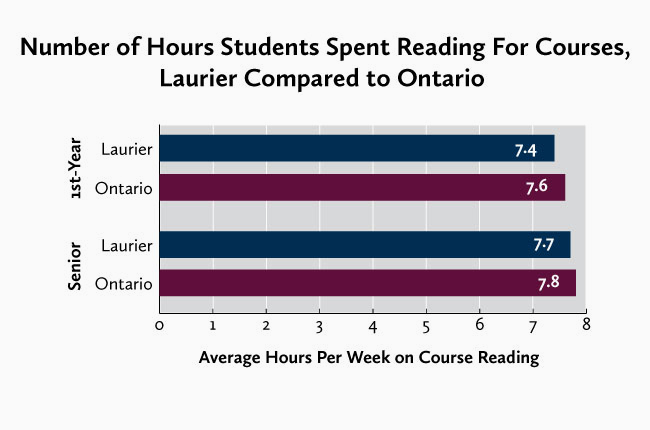
Note: The reading item is limited to 2014 institutions.
The graph below reports that:

To what extent did students' courses challenge them to do their best work? Response options ranged from 1 = "Not at all" to 7 = "Very much."
Laurier's students responded with the following:
Compared to the Ontario response of:
Laurier's students responded with the following:
Compared to the Ontario response of:

How much did students say their institution emphasizes spending significant time studying and on academic work? Response options included "Very much," "Quite a bit," "Some," and "Very little."
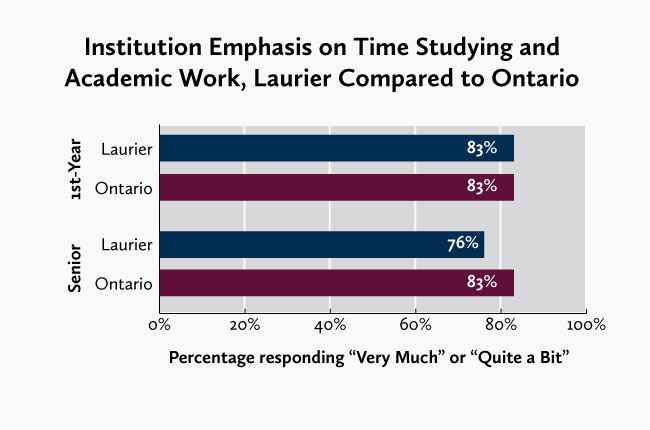
By examining individual NSSE questions, you can better understand what contributes to your institution's performance on engagement indicators and high-impact practices. This section displays the five questionsa on which your first-year and senior students scored the highest and the five questions on which they scored the lowest, relative to students in your comparison group. Parenthetical notes indicate whether an item belongs to a specific engagement indicator or is a high-impact practice. While these questions represent the largest differences (in percentage points), they may not be the most important to your institutional mission or current program or policy goals. For additional results, refer to your Frequencies and Statistical Comparisons report.
| Topic or Question | Item Number | Percentage Point Difference with Ontario |
|---|---|---|
| Quality of interactions with student services staff (...)d (QI) | 13d | +10 |
| Institution emphasis on attending campus activities and events (...)c (SE) | 14h | +10 |
| About how many courses have included a community-based project (service-learning)?e (HIP) | 12 | +10 |
| Worked with other students on course projects or assignmentsb (CL) | 1h | +9 |
| Prepared for exams by discussing or working through course material w/other studentsb (CL) | 1g | +9 |
| Topic or Question | Item Number | Percentage Point Difference with Ontario |
|---|---|---|
| Summarized what you learned in class or from course materialsb (LS) | 9c | -1 |
| Spent more than 10 hours per week on assigned readingf | 16 | -1 |
| Analyzing an idea, experience, or line of reasoning in depth by examining its partsc (HO) | 4c | -1 |
| Spent more than 15 hours per week preparing for class | 15a | -4 |
| Reviewed your notes after classb (LS) | 9b | -7 |
| Topic or Question | Item Number | Percentage Point Difference with Ontario |
|---|---|---|
| Institution emphasis on providing support for your overall well-being...c (SE) | 14f | +12 |
| Institution emphasis on providing opportunities to be involved sociallyc (SE) | 14e | +10 |
| Institution emphasis on using learning support services (...)c (SE) | 14c | +9 |
| Quality of interactions with studentsd (QI) | 13a | +8 |
| Institution emphasis on providing support to help students succeed academicallyc (SE) | 14b | +8 |
| Topic or Question | Item Number | Percentage Point Difference with Ontario |
|---|---|---|
| Reviewed your notes after classb (LS) | 9b | -5 |
| Institution emphasis on studying and academic workc | 14a | -7 |
| Spent more than 15 hours per week preparing for class | 15a | -7 |
| Worked with a faculty member on a research project (HIP) | 11e | -8 |
| Completed a culminating senior experience (...) (HIP) | 11f | -12 |
a. The displays on this page draw from the items that make up the 10 engagement indicators (EIs), six high-impact practices (HIPs), and the additional academic challenge items reported on page 2. Key to abbreviations for EI items: HO = Higher-Order Learning, RI = Reflective & Integrative Learning, LS = Learning Strategies, QR = Quantitative Reasoning, CL = Collaborative Learning, DD = Discussions with Diverse Others, SF = Student-Faculty Interaction, ET = Effective Teaching Practices, QI = Quality of Interactions, SE = Supportive Environment. HIP items are also indicated. Item numbering corresponds to the survey facsimile included in your Institutional Report and available on the NSSE Web site.
b. Combination of students responding "Very often" or "Often."
c. Combination of students responding "Very much" or "Quite a bit."
d. Rated at least 6 on a 7-point scale.
e. Percentage reporting at least "Some."
f. Estimate based on the reported amount of course preparation time spent on assigned reading.
g. Estimate based on number of assigned writing tasks of various lengths.
Students' perceptions of their cognitive and affective development, as well as their overall satisfaction with the institution, provide useful evidence of their educational experiences. For more details, see your Frequencies and Statistical Comparisons report.
Students reported how much their experience at your institution contributed to their knowledge, skills and personal development in 10 areas.
| Perceived Gains (Sorted Highest to Lowest) | Percentage of Fourth-Years Responding "Very Much" or "Quite a Bit" |
|---|---|
| Thinking critically and analytically. | 88% |
| Writing clearly and effectively. | 78% |
| Working effectively with others. | 72% |
| Speaking clearly and effectively. | 69% |
| Understanding people of other backgrounds (econ., racial/ethnic, polit., relig., nation., etc.). | 55% |
| Developing or clarifying a personal code of values and ethics. | 54% |
| Analyzing numerical and statistical information. | 52% |
| Solving complex real-world problems. | 51% |
| Being an informed and active citizen. | 50% |
| Acquiring job- or work-related knowledge and skills. | 47% |
Students rated their overall experience at the institution, and whether or not they would choose it again.
The graph below indicates that,
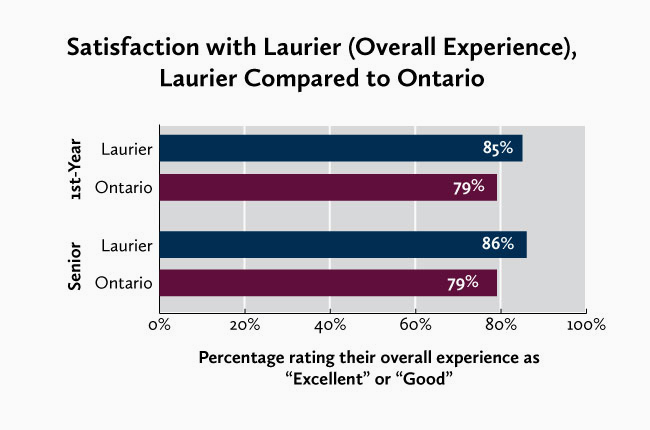
The graph below indicates that,
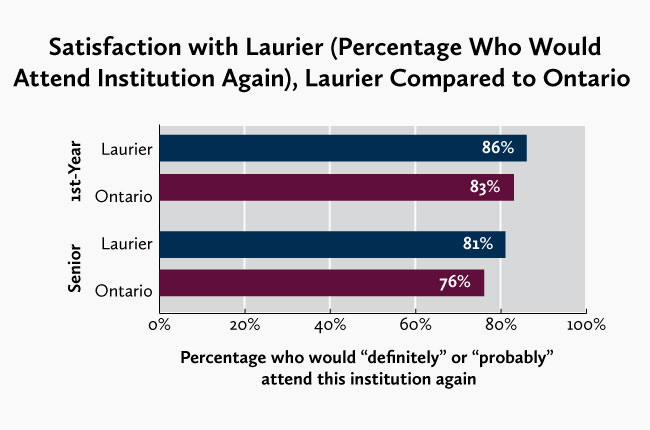
| Year | Count | Response Rate |
Female | Full-Time |
|---|---|---|---|---|
| First-year | 1,319 | 26% | 64% | 96% |
| Senior | 971 | 27% | 66% | 81% |
Refer to your Administration Summary and Respondent Profile reports for more information.
Your institution administered the following additional question sets:
See your Topical Module and Consortium reports for results.